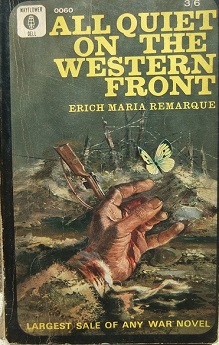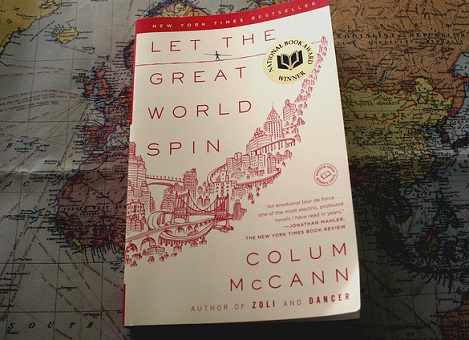 Reliable Narrator
Reliable Narrator
In an
Unreliable World
“Some first lines are so powerful that you absolutely have to keep on reading.” –Noah Lukeman
If a writer cannot hook their reader within the first sentence, paragraph, and ultimately the first chapter, then all is lost. Like a car salesman who knows that he has to make the sale before the customer leaves; “They’ll never come back, make the sale now!” is often the motto. The same goes for writing. Once a book is placed down, there’s always a chance that it may never be picked back up. A writer’s best bet is to make sure that the book is never placed down. The best way to do that is to introduce a reader to a foreign, often unreliable world—which is somewhat implicit in memoir—and give them a reliable, trustworthy, narrator.
|
“How does the reader know that they’re going to be taken through a foreign world by a guide they can trust?”
|
In this annotative essay, the first chapters of great works will be discussed—particularly non-fiction—and how it is that the authors convince us that we’re being introduced to an unreliable/foreign world with a reliable, trustworthy, narrator. The books to be focused on: A Three Dog Life by Abigail Thomas, Committed: A Skeptic Makes Peace with Marriage by Elizabeth Gilbert, Angela’s Ashes, by Frank McCourt, and Notes from the Underground by Fyodor Dostoyevsky.
As stated, the beginning of a book has the biggest, most important, job. It sets the tone. The intensity. The plot. The characters. It introduces us to the world within the pages. If the world seems too bland, too predictable, too passé, then all is lost. No person begins reading with the intent to be bored, no person reads to learn something they already know; instead, we read to escape, to be entertained, to become informed. We can’t escape to the same world in which we live, we can’t be entertained from tired words, and we can’t be informed from which we already know. A book must introduce a reader to a foreign world, an unpredictable world, a world in which they can see a possibility for entertainment, mystery, escapism, and information. It’s often said that “truth is stranger than fiction,” and in non-fiction authors often have the difficult task of taking extraordinary, unbelievably true stories, and making them believable. From the man who was hiking and had to cut off his own arm, to the pastor who claims his child went to heaven, to the man who claims he slept with thousands of women. Books implicitly introduce the reader to a foreign world and once we enter this world, we need to know that we will have a trustworthy narrator to guide us through. Because if we don’t trust the narrator then we don’t trust the world they’ve created.
|
“This doesn’t mean that the narrator is boring, simply instead that we can trust them.”
|
How does the reader know that they’re going to be taken through a foreign world by a guide they can trust? Imagine going to a museum and there’s two tour guides that you can choose. Tour guide number one is a nineteen year old, high school dropout, named Frank. Frank’s a slacker who always wears his t-shirt too big and pants too low, he only gives tours so that he has enough money to buy drugs. Tour guide number two is a sixty-five year old, retiree, named Blake. Blake has a Ph.D. in art history, and only works as a tour guide because he’s loves art and needs something to do while he’s retired.
If you were going to have a tour of an art museum, and if you had a choice, which tour guide would you prefer? The answer is easy… Blake, of course.
We chose Blake because we trust him. We trust the bow-tie that adorns the collar of his nicely ironed shirt, we trust the Ph.D. that follows the word “Blake,” on his nametag. We trust the kind hearted voice of a man who’s poured over books of art, who’s seen the Mona Lisa in the Louvre, and who’s gazed up at the Sistine Chapel. We trust Blake because when he doesn’t know something he tells us he doesn’t know. He isn’t here to be your friend or get you to like him or go out on a date with him he’s only here to tell you everything he knows about art. Everything about Blake, from the way he looks, to the way he talks, is what we would expect. He’s congruent with himself.
|
“Dostoyevsky’s narrator may be a horrible, miserable person, but he’s a horrible, miserable person that we instantly trust as our narrator.”
|
Frank, on the other hand, we don’t trust. He seems unreliable. He calls it the Sixteen Chapel instead of the Sistine Chapel, and he knows more about Kim Kardashian then Pablo Picasso. Frank is covered in tattoos but tries to hide them with long sleeves. Frank contradicts himself. At one point he tells you that he’s been working at the museum for six months, and at another point he says three months. He leaves out information about paintings during the tour; he pretends to know more than he does, he misleads you purposely, sometimes for his own amusement, sometimes just to get an easy laugh. Frank gives tours in a certain way because sometimes he’s trying to impress some pretty ladies that are in the group and sometimes he’s just trying to get a bigger tip. Frank’s intentions as a tour guide are never altruistic, he’s never reliable or congruent, and frankly, Frank is a tour guide that we simply cannot trust.
The key to presenting a reliable narrator in an unreliable world is to make sure that they are more like Blake then Frank. This doesn’t mean that the narrator is boring, simply instead that we can trust them. If we look at the beginning of Notes from the Underground by Fyodor Dostoyevsky:
“I’m a sick man . . . a mean man. There’s nothing attractive about me. I think there’s something wrong with my liver. But, actually, I don’t understand a damn thing about my sickness; I’m not even too sure what it is that’s ailing me. I’m not under treatment and never have been, although I have great respect for medicine and doctors. Moreover, I’m morbidly superstitious—enough, at least, to respect medicine. With my education I shouldn’t be superstitious, but I am just the same. No, I’d say I refuse medical help simply out of contrariness. I don’t expect you to understand that, but it’s so. Of course, I can’t explain whom I’m trying to fool this way. I’m fully aware that I can’t spite the doctors by refusing their help. I know very well that I’m harming myself and no one else. But still, it’s out of spite that I refuse to ask for the doctors’ help. So my liver hurts? Good, let it hurt even more!”
|
“We need to know that the narrator is a real person, not an amalgamation of different people or ideas, not some idealized version of a person, but a real, flesh and blood, faults and all, person.”
|
We see that what Dostoyevsky does is set up a strong intense tone of the narrator. He creates a character that has such a unique intensity that the reader is drawn forward to read more. And what’s more, he keeps up the intensity throughout the whole first chapter, and ultimately the whole book. Like Blake, he admits when he doesn’t know something, “I don’t understand a damn thing about my sickness,” he admits his mistakes, “I shouldn’t be superstitious, but I am just the same,” his vulnerabilities, “I’m a sick man . . . a mean man,” Dostoyevsky’s narrator may be a horrible, miserable person, but he’s a horrible, miserable person that we instantly trust as our narrator. Everything that we read and hear in that first paragraph is congruent with the portrait that the narrator is painting. We can see him. Similar to how Blake’s bow-tie matches his shirt, pants, and personality, so too does everything that we see of the narrator match up with the picture being painted. But the most important part is that we can actually see the narrator. It’s easier to trust a narrator that we can see.
In just the first paragraph of Notes from the Underground we get the sense of a man who is hurting, pleading, who is on bended knees baring his soul. This is another way to let a reader know that they’re dealing with a reliable narrator: vulnerability. By being upfront and admitting the faults within ourselves and our story—“I don’t understand a damn thing about my sickness; I’m not even too sure what it is that’s ailing me.”—the reader knows beforehand what they’re getting themselves into, and with whom; they know that the narrator’s not trying to pull one over on them, that they can be trusted. It is the man adorned in armor who needs it the most. But a man who takes his armor offer is a man unafraid, and it is the man who doesn’t hide that we trust. So even though the narrator that we’re being introduced to seems to be a horrible, miserable, loser of a narrator, he is also a trustworthy narrator, he is a narrator that we feel safe with, in the sense that we can see that he’s hiding nothing. He is vulnerable and we keep reading because we trust that vulnerability.
|
“We trust this vulnerability because she’s opening herself up, showing us her wounds, she’s not trying to hide, protect, or paint a perfect picture of herself, and it is vulnerability like this which makes a story great and a narrator reliable.”
|
Another way in which a narrator can set up a tone of reliability is with relatability. If a narrator is too far out-there, then they’ll be seen as unreliable and untrustworthy. If a character is set up as smart and intelligent but keeps doing dumb things, things that we know no real, normal person would do, then the narrator loses our trust. We need to know that the narrator is a real person, not an amalgamation of different people or ideas, not some idealized version of a person, but a real, flesh and blood, faults and all, person.
Dostoyevsky follows all these steps perfectly in Notes from the Underground. The first thing that he does is he sets up the main character, the narrator. He sets up the narrator so well and so succinctly that with each word, though, idea, and phrasing, the character becomes more and more alive, more relatable. Within a few sentences we’re no longer reading a book, we’re now hearing a story from the person sitting next to us. The words suddenly have eyes, and a nose, and a mouth, and fingers, and a beard, and a bald head. Next he shows us that not only is this narrator a real person who’s sitting next to us, but also that this narrator isn’t like our typical neighbor, co-worker, family member, or stranger on the bus. This narrator is sick. He’s depressive. He’s paranoid. He’s a man so stubborn, so defiant, that he refuses medical care out of spite. Spite for crying out loud! He neglects his own health for vengeance against and unknown, unnamed enemy. He’s “out-there” but not so far out-there that we would write him off as an untrustworthy, unrelatable, narrator. He may be telling us that that he’s crazy but we trust him when he tells us that he’s crazy. His actions are all congruent with who he is as a narrator. Then combined with the vulnerability we have a narrator who we can see, relate to, feel for, and who we trust to be our tour guide through the pages. We have our Blake!
Vulnerability, congruence, relatability, a narrator that we can actually see; these are the four things which most convince a reader that they’re dealing with a reliable narrator, and which ultimately keep them reading. And now that these four traits have been identified in Dostoyevsky’s work, we will look at several other successful, and not so successful, attempts at creating a reliable, relatable, vulnerable, and congruent narrator in non-fiction.
The memoir A Three Dog Life, by Abigail Thomas, begins:
“This is the one thing that stays the same: my husband got hurt. Everything else changes. A grandson needs me and then he doesn’t. My children are close then one drifts away. I smoke and don’t smoke; I knit ponchos, then hats, shawls, hats again, stop knitting, start up again. The clock ticks, the seasons shift, the night sky rearranges itself, but my husband remains constant, his injuries are permanent. He grounds me. Rich is where I shine. I can count on myself with him.”
|
“But its objective moments like this, where we may not actually believe that the narrator had the worst of the worst of upbringings, we may not believe that an Irish Catholic upbringing is the worst, but we do believe that the narrator believes it’s the worst.”
|
Immediately we’re shown a woman “my husband,” older “a grandmother,” who is stuck in a changing, “This is the one thing that stays the same…” never-changing, rut. The one place where she’s grounded, that lets her count on herself, is the one place that also gives her the most misery: her husband Rich. She invites us into her world, shows us the tedium of everyday life, and she, ultimately, spends the entire first chapter showing us how vulnerable she is: “I got stuck with the past and future. That’s my half of this bad hand. I know what happened and I never got used to that.” We trust this vulnerability because she’s opening herself up, showing us her wounds, she’s not trying to hide, protect, or paint a perfect picture of herself, and it is vulnerability like this which makes a story great and a narrator reliable. She is taking the armor off, and like a man at a strip-club, it’s the removing of the clothing which is the most alluring. She’s showing us her tattoos not hiding them under her sleeves.
The narrator of A Three Dog Life is immediately consistent with the picture being painted. She’s congruent. From the image of an older women, to the talk of her knitting, to the fact that she has only a twenty-seven inch TV. Most kids nowadays have iPads that are twenty-seven inches. But not her. She’s older. A writer. A reader. She lives in a “cozy house,” with “pretty furniture,” where “Time passes here.” She sits quietly with her husband, plays with her dogs, talks to her grandchildren. She immediately becomes a person that we can see and relate to. We recall images of older women we’ve met or seen on TV. Wives, mothers, grandmothers, friends, co-workers, the narrator shows us a glimpse of her life and it’s something that we can immediately relate to; a woman who is simply living her life as best she can in the face of tragedy. These all help us to see the picture of a woman, and when the picture matches up with the words and actions, combined with vulnerability, congruence, and relatability, then we have a reliable narrator, one that we believe we can trust. This narration is kept up throughout the book and on every page we see a narrator who is giving herself to us, who we can see, relate to, trust, and care about. This is why Stephen King called A Three Dog Life, “The best memoir I have ever read.” This means another Blake!
Let’s look at one more good example—Angela’s Ashes, by Frank McCourt—before moving onto an example where the author doesn’t set up a reliable narrator. Angela’s Ashes begins:
“My father and mother should have stayed in New York where they met and married and where I was born. Instead, they returned to Ireland when I was four, my brother, Malachy, three, the twins, Oliver and Eugene barley one, and my sister, Margaret, dead and gone.
When I look back on my childhood I wonder how I survived at all. It was, of course, a miserable childhood; the happy childhood is hardly worth your while. Worse than the ordinary miserable childhood is the miserable Irish childhood, and worse yet is the miserable Irish Catholic childhood.
People everywhere brag and whimper about the woes of their early years, but nothing can compare with the Irish version: the poverty; the shiftless loquacious alcoholic father; the pious defeated mother moaning by the fire; pompous priests; bullying schoolmasters; the English and the terrible things they did to us for eight hundred long years.”
In the first few pages, McCourt sets up a narrator that we can see. Irish and Catholic we can see those rosy white cheeks and blue eyes. We can see the tough-as-nails kid with a hard upbringing and a just as hard look at life. We can see this rough narrator and rough lens which he views the world. What is set up is a narrator who thinks that he had it the worst; that his upbringing wasn’t just the worst of the worst, it was the worst of the worst of the worst. We know that this is a narrator who is going to tell us about how bad things were for him, and he does. But its objective moments like this, where we may not actually believe that the narrator had the worst of the worst of upbringings, we may not believe that an Irish Catholic upbringing is the worst, but we do believe that the narrator believes it’s the worst. And that’s all that really matters. Memoir isn’t about perfection, it’s about point-of-view. We’re reading about a person, their thoughts, feelings, action, and in-actions in life. We need to see them and know their thoughts, no matter how faulty we may see them as. We’re not looking to see our reflection but theirs.
|
“It is hard to trust a narrator that we cannot see. And even harder still when said narrator has covered themselves in armor.”
|
Like everyone’s infamous Uncle Larry who always says he’s going to stop drinking. He might mean it every month when he says it, but we all know the truth. We know that every month he says he’ll quit, then will quit for a few hours, a day at the most, and then is right back at it. We don’t have to believe everything Uncle Larry says, or the narrator, but we do have to believe that we can trust the narrator. And just as we trust Uncle Larry to keep at it, so too do we trust the narrator of Angela’s Ashes to keep up with the voice that is set up. Frank McCourt gives us a reliable narrator.
Throughout the whole first chapter the narrator of Angela’s Ashes is shown as a man with a hard upbringing. From the stories of his father being hunted by the Irish Republican Army (“a price on his head,”) to the stories of poverty (“dad loses his job,”), alcoholism, and death (“he died of the drink,”). He shows us that he meant what he said. That he had a tough upbringing. He didn’t tell us that he had a tough childhood and then begin telling us about how rich his parents were and how much he loved them and them him. We see a narrator as a person who saw things not for better or worse but simply for what they were. This is another clear-cut example of a narrator allowing themselves to be vulnerable on the page and stay congruent with the voice and image that they’re presenting.
Most people have dealt with troubles in their life and if we see a narrator who has dealt with similar troubles, whether directly mirroring ours, or in a deep enough sense compared to ours, we will make the connection and relate with the narrator. If this is combined with vulnerability, congruence and a portrait, then we will once again experience the feeling of having a reliable narrator.
To look at something that isn’t the best of examples of the above mentioned techniques we will look at Committed: A Skeptic Makes Peace with Marriage a memoir by Elizabeth Gilbert. Committed starts off:
“Late one afternoon in the summer of 2006, I found myself in a small village in northern Vietnam, sitting around a sooty kitchen fire with a number of local women whose language I did not speak, trying to ask them questions about marriage.
For several months already, I had been traveling across Southeast Asia with a man who was soon to become my husband. I suppose the conventional term for such an individual would be “fiancé,” but neither one of us was very comfortable with that word, so we weren’t using it. In fact, neither one of us was very comfortable with this whole idea of matrimony at all. Marriage was not something we had ever planned with each other, nor was it something either of us wanted. Yet providence had interfered with our plans, which was why we were now wandering haphazardly across Vietnam, Thailand, Laos, Cambodia, and Indonesia, all the while making urgent—even desperate—efforts to return to America and wed.”
Although well-written, Committed, lacks several of the tenants which I believe make a reliable narrator, and ultimately, a good story.
For starters, though, we will look at what works well within the story: congruency. Gilbert comes across as a confused, though congruent narrator. She is in love with a man, wants to be with him, but doesn’t want to marry him—these feelings fluctuate, but we are shown a narrator who fluctuates, so we can trust those feelings. We can (at first) picture a young woman, in-love, who is going back and forth on her decision. But even this congruency eventually works against the reliability of the narrator.
Does she, though, paint a picture of the narrator? No. She does not. What we see is the image of a generic, rich woman (middle-aged?) who is a writer. We don’t see her wrinkles. The burn marks on her skin, the cigarette between her lips and drink in her hand. We see nothing. A generic woman who has a slight problem. It is hard to trust a narrator that we cannot see. And even harder still when said narrator has covered themselves in armor.
|
“A reliable narrator is someone who puts themselves into the pages. They strip off all armor and make themselves vulnerable.”
|
The problem with the narrator is that ultimately, throughout the book, we don’t trust the narrator. Which means that even though the “voice,” may be congruent with the image that’s being present, we don’t trust that voice, so the image doesn’t matter. There is no vulnerability in the pages. She is wealthy, in love, and simply has to decide whether or not to marry a man who she claimed “…loved each other unreservedly,” and which she had already made a life-long pact, “We had even sworn lifelong fidelity to each other already…” She gives us nothing. Her most famous memoir, Eat Pray Love, was a more personal book, something that showed her vulnerabilities. But those vulnerabilities are lacking in Committed. We don’t see a real person with a real problem—a woman getting over an awful divorce, like in Eat Pray Love. Now, her only problem is that she is wealthy, in a loving, committed, relationship with a rich, good-looking, tall, dark, and handsome Brazilian, someone whom she loves and has pledged her life to. And yet, her big problem is that she’s hesitant on getting married again. And these feelings teeter back and forth. She wants to get married. She doesn’t. Maybe she can find another way around this. Get married. Don’t. Etc. This is a situation that isn’t that relatable. There’s no vulnerability, so there’s nothing really for us to relate to and this is where she loses us.
Vulnerability and relatability is in the details. Like Thomas talking about her 27in TV in Three Dog Life. It just seems so pathetic. So lonely. So perfect. Or like McCourt in Angela’s Ashes. The hard childhood. The alcoholism. The deaths. The Irish Catholic guilt. He doesn’t skirt the issues. He doesn’t skirt the facts. He gives it to the reader. Gilbert does not. She gives a vague problem, doesn’t let us see her, and then gives no real details to the story, or about herself. Gilbert is the Frank of narrators. She hides her tattoos and doesn’t let us see her. We have no choice but to not trust her and cast her off.
As the New York Post wrote about the book:
“Ironically, Gilbert’s heart does not seem to have been in this book…
The book is more filler than anything, just pages and pages of rambling encounters with poor Asian people who talk to her about marriage and teach her things, then some Wiki’d historical facts, then some paeans to her worldliness and personal growth — all the while continuing to evade any real personal disclosures.”
A reliable narrator is someone who puts themselves into the pages. They strip off all armor and make themselves vulnerable. “This is me, blemishes and all.” No one wants to read a book that is layered in chain-mail. We see nothing, only manufactured goods, we don’t see the flesh and bones and blood, which is what we want. To create a reliable, memorable, trust-worthy narrator, someone who we want guiding us through the foreign world of a book, we need someone who is vulnerable, relatable, congruent, and who we can see. Someone who we may not like, but who we can trust.
More related craft essays, book notes, and MFA notes.
Picture: Flickr/mpclemens















